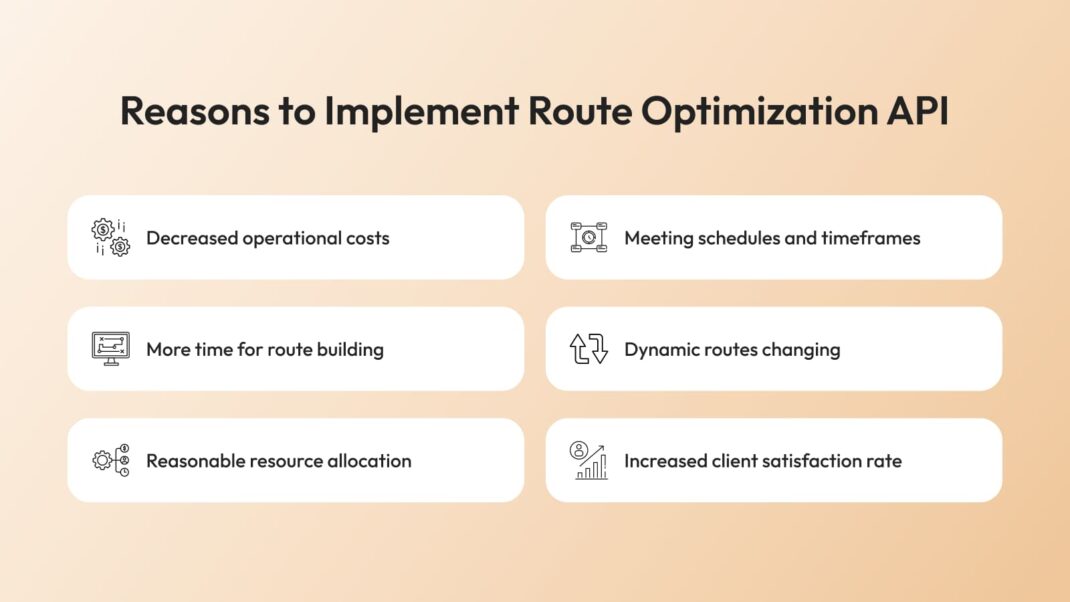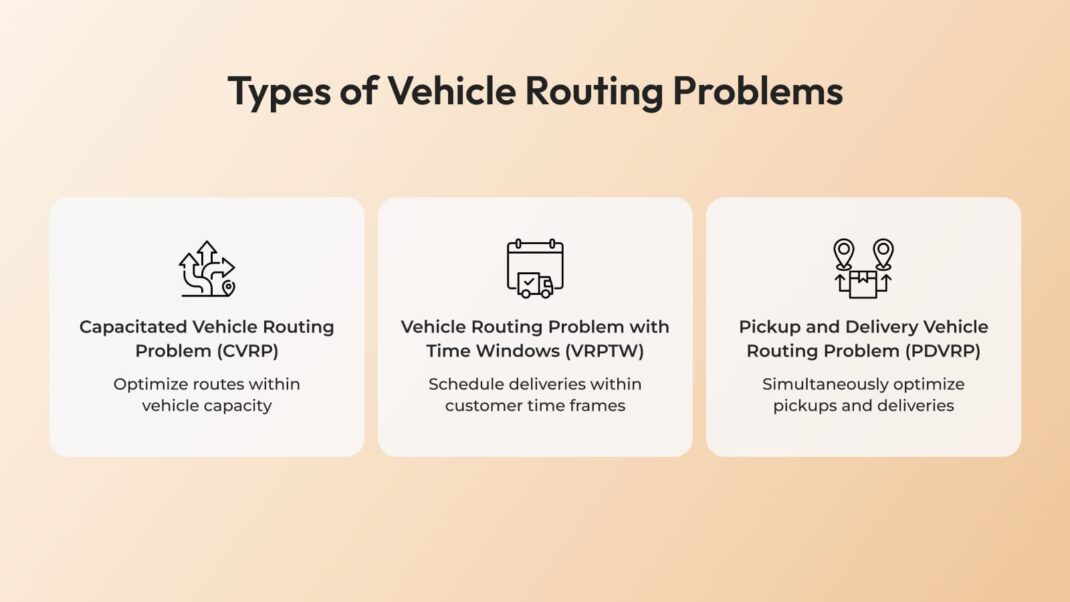An intricate and vital component of corporate operations has always been logistics. The obstacles involved sometimes seem infinite, ranging from overseeing fleets of vehicles to making sure deliveries are done on schedule. Thankfully, there are strong technological solutions available. A technology that has been increasingly popular in recent years is the Route Optimization API. Businesses may save time, money, and resources by automating their route planning and developing more effective logistical procedures by utilizing these APIs.
What is Route Optimization API?
In its simplest sense, a Route Optimization API is a tool that assists companies in determining the best routes for their delivery trucks to travel while taking into account variables such as distance, traffic, road closures, and delivery priority. By automating the decision-making process and integrating with current fleet management or logistics systems, the API lowers human error and saves crucial time.
Take, for instance, a fleet management business that operates many trucks. Each driver may choose a different route to get to their destination if route optimization is not done, which might cause delays and inefficiencies. Through the use of an API, the system determines each driver’s shortest and most fuel-efficient route in real time, making dynamic adjustments in response to new information (such traffic patterns).
The beauty of Route Optimization APIs is their flexibility. They don’t just suggest the shortest path; they consider the bigger picture. This means taking into account the real-time conditions that can affect travel times, like weather, road closures, accidents, and even historical traffic patterns. These features ensure that the routes are not only efficient but also reliable, even when unexpected circumstances arise.
How the Route Optimizing API Addresses the Vehicle Routing Problem
The Vehicle Routing Problem (VRP) is a well-known optimization problem in transportation and logistics. It centers on how to distribute deliveries among a fleet of cars in a way that respects client delivery windows and other limitations while reducing fuel consumption and trip time.
Consider a five-truck delivery service that is responsible for delivering packages to many places. The difficulty lies not only in figuring out the quickest route for each truck but also in determining the optimal overall route that reduces the total travel time for all involved trucks. This is the point at which Route Optimization APIs truly shine.
Take, for instance, a courier service that delivers goods for online retailers. Every delivery has a window of time, and the business must make sure that clients receive their items inside that window. By limiting travel lengths as short as possible, the corporation hopes to decrease fuel expenses and vehicle wear and tear. The API optimizes each vehicle’s route based on all of these factors, guaranteeing on-time delivery while optimizing efficiency.
The problem becomes even more complicated when factoring in things like seasonal fluctuations in demand, road construction, or unexpected traffic events. Route Optimization APIs are designed to adapt to these real-time changes, recalculating routes as new information becomes available. This dynamic approach ensures that businesses can respond quickly to disruptions and continue to meet customer expectations, no matter what.
Routing Optimization Algorithm Types
The magic is performed by the algorithms that underpin Route Optimization APIs. The problem of route optimization is solved using a variety of methods, depending on the particular requirements of the company. These algorithms may be broadly categorized into two groups: dynamic and static.
Static Algorithms
The purpose of static algorithms is to determine routes using a predetermined set of inputs. For instance, the road network, the distance between destinations, and the anticipated travel times under typical circumstances may all be taken into consideration while planning a route. When conditions don’t change often, such when the routes are familiar and predictable, these algorithms are usually employed.
For example, a business that delivers goods on a regular basis to fixed locations may arrange its routes using a static algorithm. At the beginning of the day, the algorithm would determine the most efficient routes; until the business manually adjusts them, those routes would remain the same.
While static algorithms can be effective in stable environments, they lack the flexibility needed to adjust for unexpected events like traffic jams or accidents. This is where dynamic algorithms come into play.
Dynamic Algorithms
Real-time data is taken into consideration by dynamic algorithms, which modify routes as needed. Road closures, traffic variations, weather, and any other element that might impact travel time can all be handled by them. Businesses with high delivery volumes that need frequent modifications or those operating in uncertain conditions may find this kind of algorithm very helpful.
For instance, dynamic route optimization is crucial to ride-sharing services like Uber and Lyft. The algorithm recalculates the optimal routes in real-time to take traffic and other variables into account when drivers finish trips and new customers request rides.
Delivery drivers’ routes can be modified using dynamic algorithms in the logistics industry in response to unforeseen changes in delivery schedules or real-time traffic data. The algorithm can promptly redirect the cars to prevent delays and maintain the delivery schedule in the event of a road closure brought on by an accident or construction.
Dynamic algorithms improve the responsiveness and efficiency of logistics operations, lessening the effects of unplanned delays and guaranteeing on-time delivery.
Route Optimization API Integration
Thanks to the increasing number of APIs on the market, integrating a Route Optimization API into a company’s logistics system is typically simple. The majority of Route Optimization APIs are intended to integrate easily with widely used transportation and fleet management applications.
After integration, the API can automatically determine each vehicle’s optimal route while taking into account real-time information from outside sources such as traffic reports, weather predictions, and GPS devices. What are Route Optimization APIs? How Do They Work?
Logistics has always been a complex and essential part of business. The challenges themselves would seem to be virtually limitless, from managing fleets of vehicles to ensuring deliveries happen on time. Fortunately, there are powerful technological solutions. One technology that gained popularity in the last years is the Route Optimization API. Using these APIs, businesses can automate their route planning and create more streamlined logistical processes to save time, money, and resources.

How does Route Optimization API Work?
Fundamentally, a Route Optimization API is a software interface that enables businesses to identify the optimum paths their delivery vehicles should follow, factoring in considerations like distance, traffic patterns, road blockages, and delivery urgency. By automating the decision-making process and integrating with existing fleet management or logistics systems, the API reduces human error and saves valuable time.
Consider a fleet management company with multiple trucks in operation. Without handling route optimization, each driver can opt their own way of returning to their destination which can create delays and inefficiencies. Using an API, the system calculates the shortest and most fuel-efficient route for each driver in real time, with automatic adjustments as new information (such as traffic patterns) becomes available.
Route Optimization APIs are generally flexible. They don’t simply plot the quickest route; they have an eye on the bigger picture. This involves factoring in real-time conditions that impact your travel time, such as weather, road closures, accidents and even historical traffic patterns. In addition to efficiency, though, you can bank on reliability with these features, even in the face of the unexpected.
How the Route Optimizing API Solves the Vehicle Routing Problem
Transportation is concerned with distributing people and goods across different locations, a well-studied decision optimization task known as the Vehicle Routing Problem (VRP). It focuses on the logistics of how to distribute deliveries across a fleet of cars such that customer delivery windows and other constraints are honored, while minimizing fuel spent and trip time.

Imagine a delivery service with five trucks to deliver packages to different locations. In fact the most difficult part is not only to calculate the best route to follow on each truck, but a route that is the best overall that minimizes the total time for all the trucks involved. This is where Route Optimization APIs come into the picture.
Consider, for example, a courier service that delivers goods on behalf of online retailers. Each delivery comes with a time window, and the business has to ensure that customers receive their goods within that window. The corporation plans to reduce fuel and vehicle wear costs by keeping travel distances as short as possible. The API then selects potential routes for each vehicle, optimizing for all of these factors, ensuring they land early for on-time delivery and getting as many deliveries as they can.
Things heat up even more when you factor in seasonal demand, roadway construction, or other unpredictable events on the route.
Last mile delivery software integrates with route optimization APIs to solve these challenges. Such APIs consider dynamic factors, recalculate routes when new information arrives. The ability to adapt to circumstances as they arise enable organizations to successfully do business and keep stakeholders satisfied regardless of the situation.
Types of Routing Optimization Algorithm
Depending on the specific needs of the business, the problem of route optimization is solved in different ways. These algorithms can be roughly divided into two categories: dynamic and static.
Static algorithms
Static algorithms create routes through a static set of input. The road network, the distance between the destinations, the time it would take under normal conditions, etc. These algorithms are normally used when there is no sense of urgency to change conditions (i.e., when routes are known and predictable).
An example would be a company that delivers goods consistently to stationary locations, the routes can be planned with a static algorithm. Each morning, the algorithm would select the most efficient routes, and unless the business manually changed them, those routes would stay the same.
Static algorithms yield high efficiency during the training periods, but are brittle as they do not respond adequately in the presence of an unforeseen event (e.g. traffic jam, accident). Dynamic algorithms come into play in these contexts.
Dynamic algorithms
Dynamic algorithms, consider real-time data and adjust routes accordingly. They account for road closures, variations in traffic, weather and any other factor that might influence travel time. This type of algorithm can be extremely useful for businesses that have high delivery volumes and need regular adjustments or those that operate in an uncertain environment or a blind spot.
For example, dynamic route optimization is important to ride-sharing businesses like Uber and Lyft. As such, when drivers complete trips and new customers request rides, the algorithm recalculates which would be optimal for drivers in real time, considering traffic and other variables.
Moreover, logistics companies use dynamic algorithms to programmable the routes of delivery drivers, based on sudden changes in delivery timings or live traffic data. If, for example, an accident or construction has closed a road, the algorithm can quickly reroute the cars to avoid delays and maintain the delivery schedule.
Dynamic algorithms also make logistics operations more responsive and efficient, minimizing the impact of unplanned delays and ensuring on-time delivery.
Key Route Optimization APIs Integrations
Because of the growing range of APIs available on the market, including a Route Optimization API into a company’s logistics system is usually a simple task. Most Route Optimization APIs are designed to easily integrate into popular transportation and fleet management applications.
Once integrated, the API formulates an ideal track for every automobile while considering real-time data received through third-party sources like traffic reports, weather forecasts, GPS devices, etc.
So, the API is just an added layer of intelligence that optimizes the infrastructure of businesses that already have a good logistics system in place.
The first step of the integration process is usually mapping the delivery data (locations, time periods, delivery priorities, etc.) into the API. Using its algorithms to find the best routes, the API sends this data back to the fleet management system. From there, drivers can use in-car navigation systems or their mobile devices to obtain up-to-date route information.
For example, if there is a food delivery service, it may use a route optimization API to change delivery routes in real-time based on consumer requests. Whenever a consumer places an order just before lunch, the technology recalculates the routes to prioritize local deliveries to ensure that the meal arrives hot.
The advantages of such integration are evident — reduced time spent in manual route planning, less delays, lowered operational costs, and a more scalable logistics solution that scales with the business as it grows.
If you need your application to manage deliveries, service vehicles, or field staff, we at Cleveroad can help you add advanced routing features. We seamlessly connect your mobile or web app with top mapping and logistics platforms. This integration means your app can instantly find the most efficient routes, handle real-time changes, and provide accurate arrival times, ultimately helping you reduce operational costs and significantly improve customer satisfaction.
We focus on delivering scalable and customized solutions, including integrations for:
- Optimal route calculation: Connecting to advanced engines (like Google Maps, HERE, or custom algorithms) to plan the fastest and shortest paths for multi-stop trips.
- Live traffic and ETA: Integrating real-time traffic data to calculate highly accurate Estimated Times of Arrival and dynamically adjust routes for drivers.
- Geofencing: Setting up virtual boundaries to trigger automatic actions, such as sending a customer notification the moment a delivery vehicle arrives.
- Real-time tracking: Implementing location APIs to provide continuous, accurate tracking of vehicles or personnel, visible to both managers and end-users.
- Fleet Management Systems: Linking routing services with internal dispatch and workforce management tools to optimize task assignments and schedules.
Wrapping Up
Through this, they can cut down on fuel cost for the business, provide quicker deliveries to overcome the competition, and ensure that their customers always get their products on time by integrating these APIs into the systems used in the business. Route optimization technology is continuously evolving, and as it does, so will the benefits to businesses and their customers. Whether your fleet is large or small, investing in a Route Optimization API will keep you ahead of the curve and ensure that your clients will never be disappointed again.
